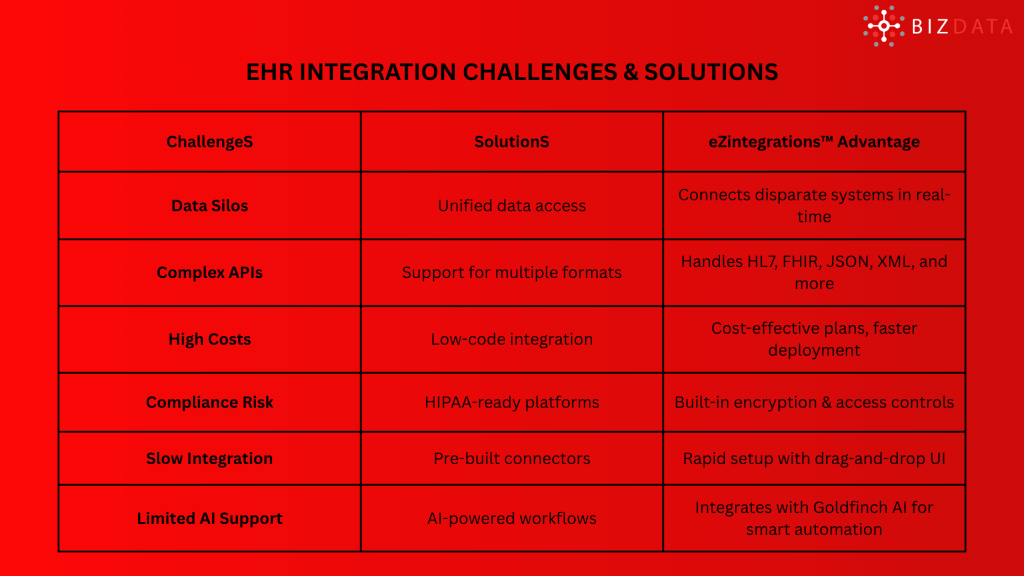Electronic Health Record (EHR) integration is no longer optional for modern healthcare. It’s a strategic imperative. With over 90% of hospitals in the U.S. using EHR systems (Source: HealthIT.gov), the ability to exchange data across platforms is crucial for clinical workflows, patient care, and compliance.
Yet, EHR integration challenges continue to plague health IT leaders. From incompatible systems to regulatory complexity, these issues prevent healthcare organizations from reaching the full potential of their digital transformation efforts.
This blog breaks down the top 7 EHR integration challenges every Health IT leader should know in 2025 and what you can do about them. Whether you’re managing hospital systems or leading a digital health startup, you’ll walk away with practical insights and AI-ready solutions.
Many healthcare organizations operate with fragmented systems, creating isolated data silos. This lack of interoperability makes it difficult for providers to get a complete view of patient data.
Key Pain Points:
Solution:
eZintegrations™ supports multi-format integration and real-time sync, eliminating data silos effectively
Many hospitals still rely on outdated or proprietary systems that were not built for interoperability.
Key Pain Points:
Solution:
Use low-code integration platforms like eZintegrations™ to connect legacy and modern systems
Leverage Goldfinch AI to extract structured data from scanned documents and PDFs
EHR systems store sensitive patient data, making compliance with HIPAA and other data regulations a major concern.
Key Pain Points:
Solution:
Adopt Zero Trust security frameworks
Use audit-ready platforms with built-in logging and alerts
eZintegrations™ provides secure API connections and granular access management
Custom coding every integration takes time, money, and skilled developers—resources that many healthcare providers lack.
Key Pain Points:
Solution:
Use drag-and-drop, reusable workflows in no-code/low-code platforms like eZintegrations™
Connect to 1,000+ prebuilt APIs via the Bizdata API Marketplace

Without real-time data synchronization, care coordination becomes disjointed, and delays may impact patient outcomes.
Key Pain Points:
Solution:
Implement cloud-native platforms with live sync capabilities
Use intelligent agents for continuous background data exchange
Use AI-driven document understanding tools like Goldfinch AI
Automatically structure and validate unstructured data before syncing with EHRs
eZintegrations™ enables real-time event-based syncing
A large portion of healthcare data is still unstructured—think faxes, scanned prescriptions, or handwritten notes.
Key Pain Points:
Solution:
Use AI-driven document understanding tools like Goldfinch AI
Automatically structure and validate unstructured data before syncing with EHRs
Many EHR vendors restrict integration access or charge steep fees for data exchange.
Key Pain Points:
Solution:
Choose vendor-neutral integration platforms
Leverage tools that allow BYO APIs (bring your own APIs)
eZintegrations™ and Goldfinch AI work across systems without lock-in, supporting REST, ODATA, GraphQL, and more
Looking ahead, healthcare organizations are embracing predictive AI, intelligent document processing, and cloud-native automation to stay ahead.
Forward-Looking Strategies:
Health IT leaders must navigate complex EHR integration challenges with a strategic and modern approach. By embracing AI, automation, and low-code platforms, organizations can unlock data interoperability, reduce inefficiencies, and improve patient care.
Ready to simplify your EHR integrations? Book your free demo of eZintegrations™ today.
Common challenges include system incompatibility, data silos, high integration costs, and lack of real-time sync.
Use low-code integration platforms like eZintegrations™ that connect modern APIs with legacy systems.
It ensures seamless data exchange, which improves care coordination, patient outcomes, and regulatory compliance.
AI can structure unstructured data, automate workflows, and enable predictive analytics for better clinical decisions.
Yes, eZintegrations™ is built for HIPAA compliance with secure data exchange, access controls, and audit logs.